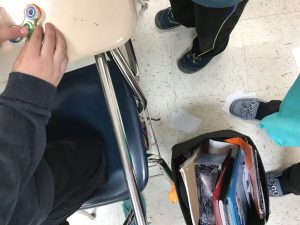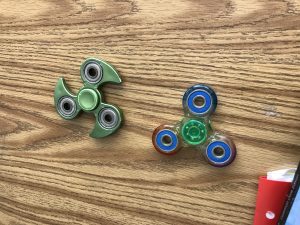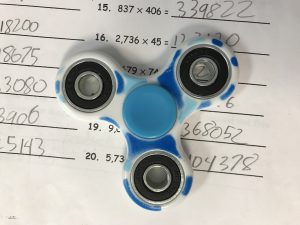I don’t want to point fingers. I don’t want to step on teachers’ or administrators’ toes as I write this post. But Holy Popcorn, Batman! How did we get all these fidget spinners into classrooms? If this were an alien invasion, and spinners were mind-control devices, most of America’s youth would be marching onto waiting spaceships, pacified and ready to become fodder for cookbook recipes.
How to serve man? I recommend against giving him fidget spinners. Those cute little devices help no one. Oh, somewhere out there, I’m sure we can find a student with ADHD who spins that thing mindlessly and manages to focus better on his mathematics because his hands are occupied.
Now let’s invent a scale. On one side, we will put distractable students who benefit from fidget spinners. On the other side, we will put students who are distracted by fidget spinners. I know what this scale looks like, and to my principal friend who thinks these spinners are better than bottle flipping, he’s right. But when did we decide to enable bottle flipping? Spinners are merely an extension of the loss of adult control that let those bottles fly.
Has education reached a point where students think they can flip water and other bottles in class? Obviously the answer is yes. I wrote a post on bottle flipping some months ago, the last big craze in local classrooms. I saw those bottles for weeks and weeks. I seized those bottles for weeks and weeks. Now I see fidget spinners. At first, I took pictures. I’ve quit now. My phone does not need 300 pictures of random fidget spinners. If I’d asked students to lay out their spinners in the middle schools where I subbed during the last few weeks, I would not have been stunned to hit 300.
Parents may be trying to hold the line but, if so, I have an alert for them: Students are selling fidget spinners to each other. I watched as an elementary teacher stayed and took control of a class where I was supposed to substitute. Her emergency lesson came because one girl sold a fidget spinner to another for $10 but then may or may not have provided the fidget. The seller said she had placed it in the other girl’s locker and it must have been stolen. The buyer naturally wanted her $10 back. How old were these girls? Eight? The new class rule was simple. No selling fidget spinners ever. No selling items to classmates.
But the rule was not, “No fidget spinners!”
These little toys are thieves of time. They are too engrossing to serve as true fidget toys, objects given to students to help them stay calm and focused. For some time now, teachers have been providing fidget toys to students, accepting some students’ need for movement and touch. The first fidget toys arrived in the classroom as part of IEPs, Individual Education Plans, managing to slither in as part of special education and related accommodations, and sometimes they worked. Fidget toys can help students use pent-up energy while focusing on teachers and classwork. Some students do have an easier time focusing on academics when clenching a squeeze ball. They distract the class less when using their fidget toys, too.
Eduhonesty: Many teachers are now seizing these cute, little, spinning devices. Some schools have banned them. But I remain baffled by the sheer number of “fidget” spinner toys that have not yet been banned. Fidget spinners do not help students pay attention; they have exactly the opposite effect. Eyes are drawn to spinning fidget spinners. The metal ones especially make interesting noises. That cream-colored one above glows in the dark. Students threw jackets over my head to demonstrate this much-admired effect.
In the meantime, under the guise of “behavioral support,” fidget spinners are being sold by the local pharmacy, big box stores, and even the local garden center. A little boy next to me today at a wedding reception was spinning his toy while an older sister ignored him, glued to her phone, earbuds blocking out the conversation around her.
I support fidget toys. If someone wants to hand a distractable student a squeeze ball or similar fidget toy, I have no problem with that strategy. The IEPs came up with those toys for a reason. For the right kids, fidget toys make education more manageable.
I DO NOT SUPPORT FIDGET SPINNERS. WHIRLY TOYS ARE TOO MUCH FUN, AND THAT SPINNING EFFECT CAN BE HYPNOTIC. When I subbed on Friday, a kid asked me if I thought spinners helped people concentrate. I told him, “No, students start paying attention to the spinner instead of the teacher.” He agreed with me. A number of students in the class agreed with both of us. A few others missed part of the discussion because they were playing with spinners.
I keep seizing spinners, putting those spinners in my little cross-shoulder bag. The bag gets heavy by the third or fourth spinner. I’m lucky. I look trustworthy. When I promise to hand the toy back at the end of class, students believe me, so I don’t have trouble. As a sub, I am not going to do much more than put these toys out of reach during class. If schools had hard policies, I might do more, but what I am coming across is, “It’s up to the teacher.”
Here are a few questions that beg for answers:
Why are administrations weaseling? Why should any object toxic to learning be “up to the teacher”? Why not ban fidget spinners — now that we have seen their effects? No student needs a fidget spinner. Many less troublesome fidget toys exist.
And a few more questions:
When did we hand control of the classroom over to the students? Why didn’t we throw every water bottle out on the spot? Why are we not seizing those spinners and making parents come in to pick them up? Are we being too nice, trying to be our students friends? Or are we just too swamped with meetings, data and testing to keep calling all the parents we would have to call to shut down the spinner invasion?
If a class loses 6 minutes to watching spinners per day, that means 1/2 hour of instruction was lost at week’s end — or 18 hours of instruction will be lost by year’s end. What if that time loss occurs in multiple classes? Fidget spinners should not be regarded either as unimportant toys or as helpful coping mechanisms. Mild distractions cannot be ignored in education.
Theft of learning time has never been a victimless crime.









